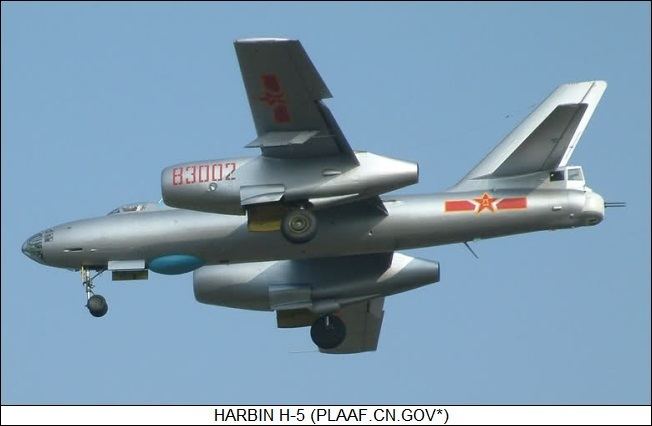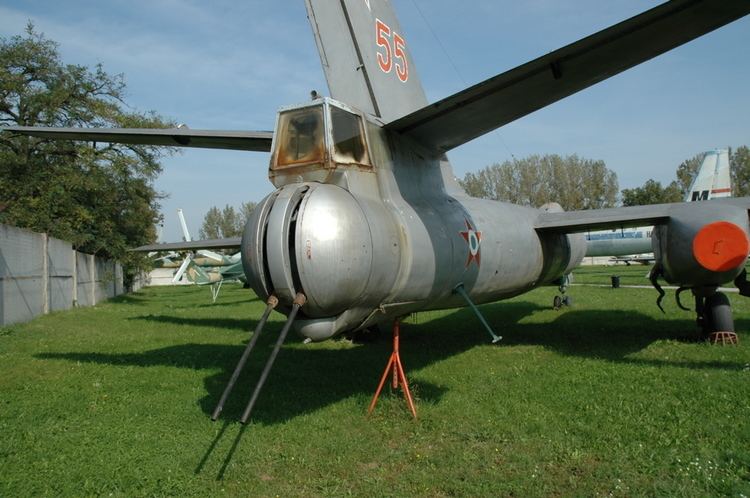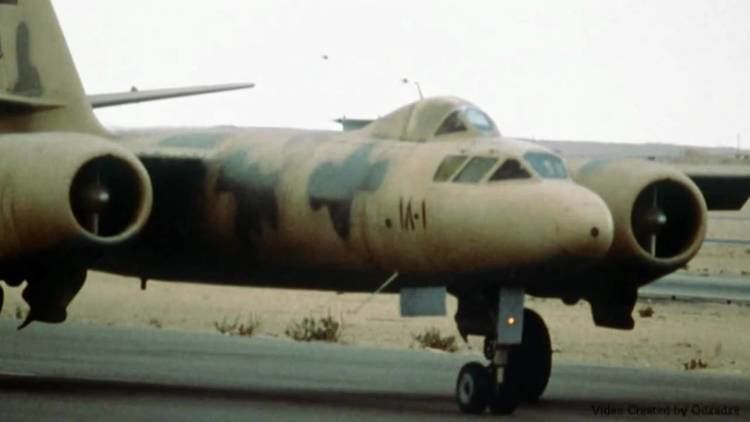Top speed 902 km/h Length 18 m Cruise speed 770 km/h First flight July 8, 1948 | Range 2,180 km Wingspan 21 m | |
 | ||
The Ilyushin Il-28 (Russian: Илью́шин Ил-28 NATO reporting name: Beagle) is a jet bomber of the immediate postwar period that was originally manufactured for the Soviet Air Forces. It was the Soviet Union's first such aircraft to enter large-scale production. It was also licence-built in China as the Harbin H-5. Total production in the USSR was 6,316 aircraft, and over 319 H-5s were built. Only 187 examples of the HJ-5 training variant were manufactured. In the 1990s hundreds remained in service with various air forces over 50 years after the Il-28 first appeared. The only H-5s in service currently are approximately 80 aircraft which operate with the Korean People's Air Force. The Il-28 has the USAF/DoD reporting name "Type 27" and NATO reporting name "Beagle", while the Il-28U trainer variant has the USAF/DoD reporting name "Type 30" and NATO reporting name Mascot. The Finnish Air Force nickname of the Il-28 was Nikita.
Contents
- Ilyushin il 28 tupolev tu 14 soviet bombers
- Design and development
- Operational history
- Soviet Union variants
- Czechoslovakia variants
- Chinese variants
- Operators
- Specifications Il 28
- References

Ilyushin il 28 tupolev tu 14 soviet bombers
Design and development

After a number of attempts at a four-engined bomber (the Lyulka TR-1 powered Ilyushin Il-22 and the unbuilt Rolls-Royce Derwent powered Ilyushin Il-24), the Ilyushin Design Bureau began development of a new jet-powered tactical bomber in late 1947. Western Intelligence focused on the four-engine developments while the twin-engine Ilyushin Il-28 was created to meet a requirement for a bomber to carry a 3,000 kilograms (6,600 lb) bombload at 800 kilometres per hour (500 mph). The new design took advantage of the sale of a number of Rolls-Royce Nene jet engines by Great Britain to the Soviet Union, which allowed Soviet engineers to quickly produce an unlicensed copy of the Nene, the RD-45, with Ilyushin designing the new bomber around two RD-45s.

The Il-28 was smaller than the previous designs and carried a crew of only three (pilot, navigator and gunner). It was also smaller than the competing design from the Tupolev design bureau, the three-engined (i.e. two Nenes and a Rolls-Royce Derwent) Tupolev Tu-73, which had been started long before the Ilyushin project, and flew before the design of the Il-28 was approved.

The Il-28 design was conventional in layout, with high, unswept wings and a swept horizontal tail and fin. The engines were carried in bulky engine nacelles slung directly under the wings. The nosewheel retracted rearwards, while the mainwheels retracted forwards into the engine nacelles. The crew of three were accommodated in separate, pressurised compartments. The navigator, who also acted as bombardier, was accommodated in the glazed nose compartment and was provided with an OPB-5 bombsight based on the American Norden bombsight of the Second World War, while the pilot sat under a sideways opening bubble canopy with an armoured windscreen. The gunner sat in a separate compartment at the rear of the fuselage, operating a power driven turret armed with two Nudelman-Suranov NS-23 23 mm cannons with 250 rounds each. In service, the turret was sometimes removed as a weight saving measure. While the pilot and navigator sat on ejector seats, the gunner had to parachute out of a hatch in the floor in the event of an emergency. Two more fixed, forward-firing 23 mm cannon with 100 rounds each were mounted under the nose and fired by the pilot, while a bomb bay was located under the wing, capable of holding four 100 kg (220 lb) bombs in individual containers, or single large bombs of up to 3,000 kg (6,600 lb) slung from a beam in the bomb bay.
One unusual design feature of the Il-28 was that the wings and tail were split horizontally through the centre of the wing, while the fuselage was split vertically at the centreline, allowing the separate parts to be built individually and fitted out with systems before being bolted together to complete assembly of the aircraft. This slightly increased the weight of the aircraft structure, but eased manufacture and proved to be more economical.
The first prototype, powered by two imported Nenes, made its maiden flight on 8 July 1948, with Vladimir Kokkinaki at the controls. Testing was successful, with the Il-28 demonstrating good handling and reaching a speed of 833 km/h (518 mph). It was followed on 30 December 1948 by the second prototype, with Soviet built RD-45 engines replacing the Nenes. After the completion of state tests in early 1949 the aircraft was ordered into large scale production on 14 May 1949, with the Klimov VK-1, an improved version of the RD-45 to be used in order to improve the aircraft's performance. The first pre-production aircraft with VK-1 engines flew on 8 August 1949, and featured reshaped engine nacelles to reduce drag, while the radome for the navigation radar was moved from the rear fuselage to just aft of the nosewheel.
Full production in three factories started in September 1949, with service deliveries starting in early 1950, allowing 25 Il-28s to be displayed at the Moscow May Day parade of 1950 (as ordered by Joseph Stalin when it was ordered into production in 1949). The Il-28 soon became the standard tactical bomber in the Soviet forces and was widely exported.
Operational history
The Il-28 was widely exported, serving in the air arms of some 20 nations ranging from the Warsaw Pact to various Middle-Eastern and African air forces. Egypt was an early customer, and targeting Egyptian Il-28s on the ground was a priority for the Israeli Air Force during the Suez Crisis, Six Day War, and Yom Kippur War. The Soviet Union was in the process of providing the type for local assembly in Cuba when this was halted by the Cuban Missile Crisis, after which Nikita Khrushchev agreed to remove them. The type also saw limited use in Vietnam and with the Afghan forces in Afghanistan. Four ex-Egyptian and two ex-Soviet Il-28s (all with Egyptian crews) were operated by the Nigerian Air Force in the Biafra Wars. Yemeni Il-28s took part in the civil war in that country. Finland also had four examples of this type delivered between 1961 and 1966 for target-towing duties. They remained in service until the 1980s.
The Soviet Union withdrew the type in the 1980s, while the last Soviet-built examples were still flying in Egypt into the 1990s.
The People's Republic of China received over 250 Soviet built Il-28s from 1952, and when the Sino-Soviet split occurred in the late 1950s, it decided to place the Il-28 into production, despite no manufacturing license being obtained. Chinese built aircraft differed from the original Soviet aircraft in that they have a redesigned wing structure, abandoning the horizontal manufacturing break, saving 110 kilograms (240 lb) at the cost of more difficult construction. Chinese aircraft also used a different tail turret based on that of the Tupolev Tu-16, and fitted with faster firing AM-23 cannon.
Chinese-built Il-28s designated H-5 and built by HAMC were also flying in the 1990s with several hundred in China itself, and a smaller number in North Korea and Romania. The three main Chinese versions are the H-5 bomber, followed by the HJ-5 trainer, and the H-5R (HZ-5) long range (in comparison to the reconnaissance version of Shenyang J-6) reconnaissance aircraft, and later, the HD-5 ECM/ESM version. The latter two types have been phased out.
The type is known to still be in active service with the North Korean Air Force in respectable numbers, although little is known as to whether they are a mix of survivors from the batch of 24 Soviet manufactured aircraft delivered in the 1960s and some of the newer Chinese built H-5 variant, or are solely H-5s. Some of these are probably used for spares to maintain a small group of around a dozen serviceable aircraft. They give North Korea a means of strategically bombing targets in South Korea and Western Japan, although they would be vulnerable to modern anti air missiles and interceptors.
Several Ilyushin Il-28s are preserved in museums and as monuments in Russia, Germany, Hungary and in other countries.
Soviet Union variants
Note: Order of variants determined chronologically by production/development dates.
Czechoslovakia variants
Chinese variants
Operators
Specifications (Il-28)
Data from Jane's All The World's Aircraft 1982–83
General characteristics
Performance
Armament
